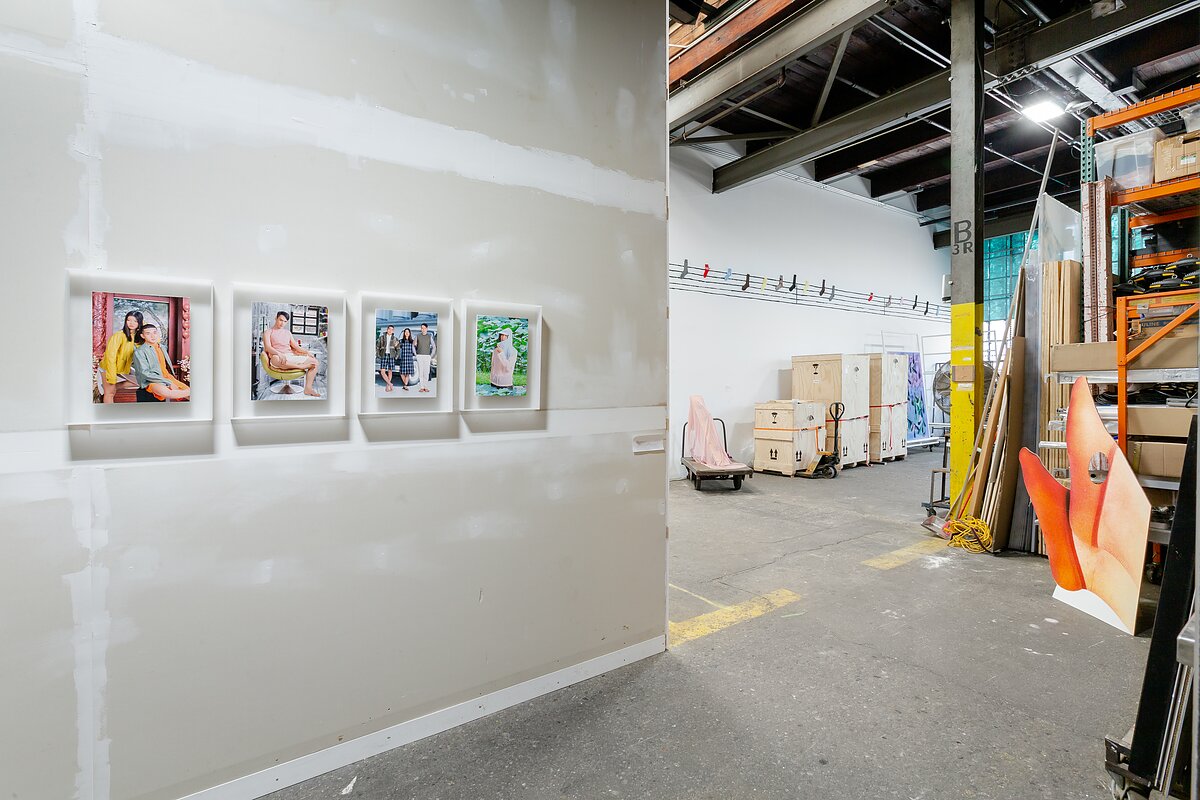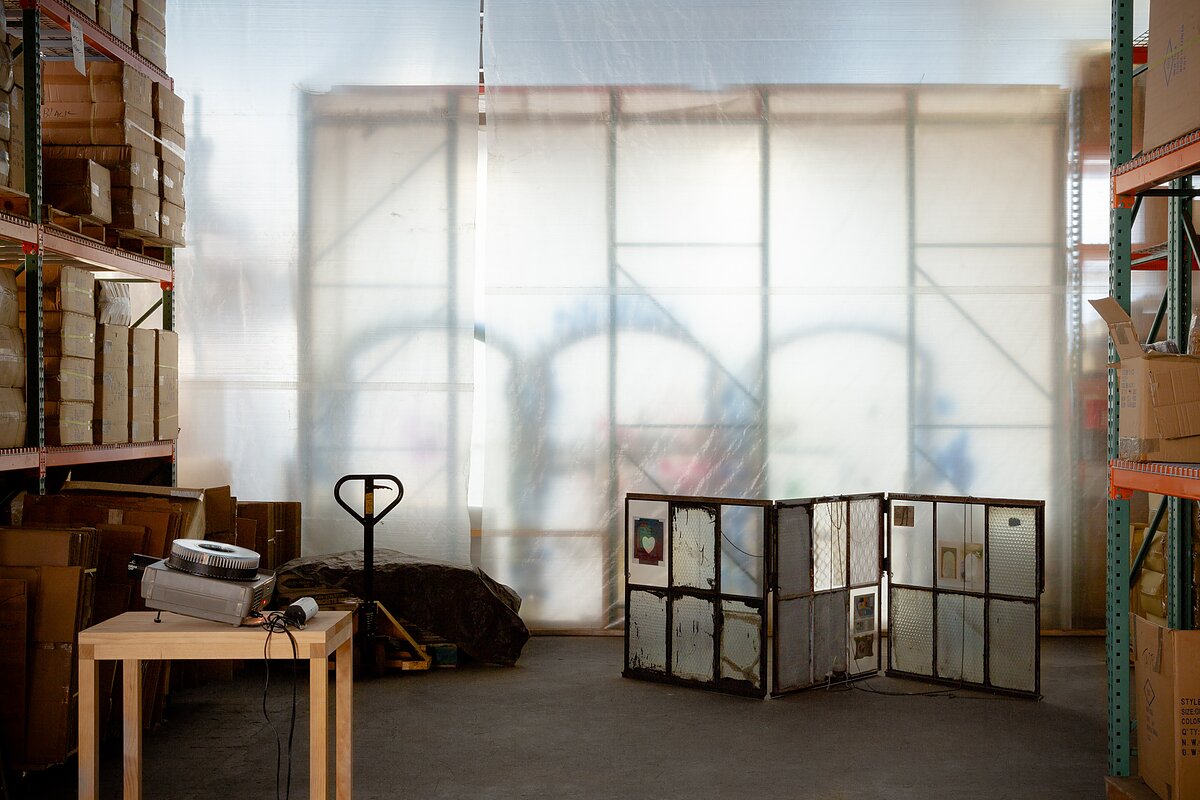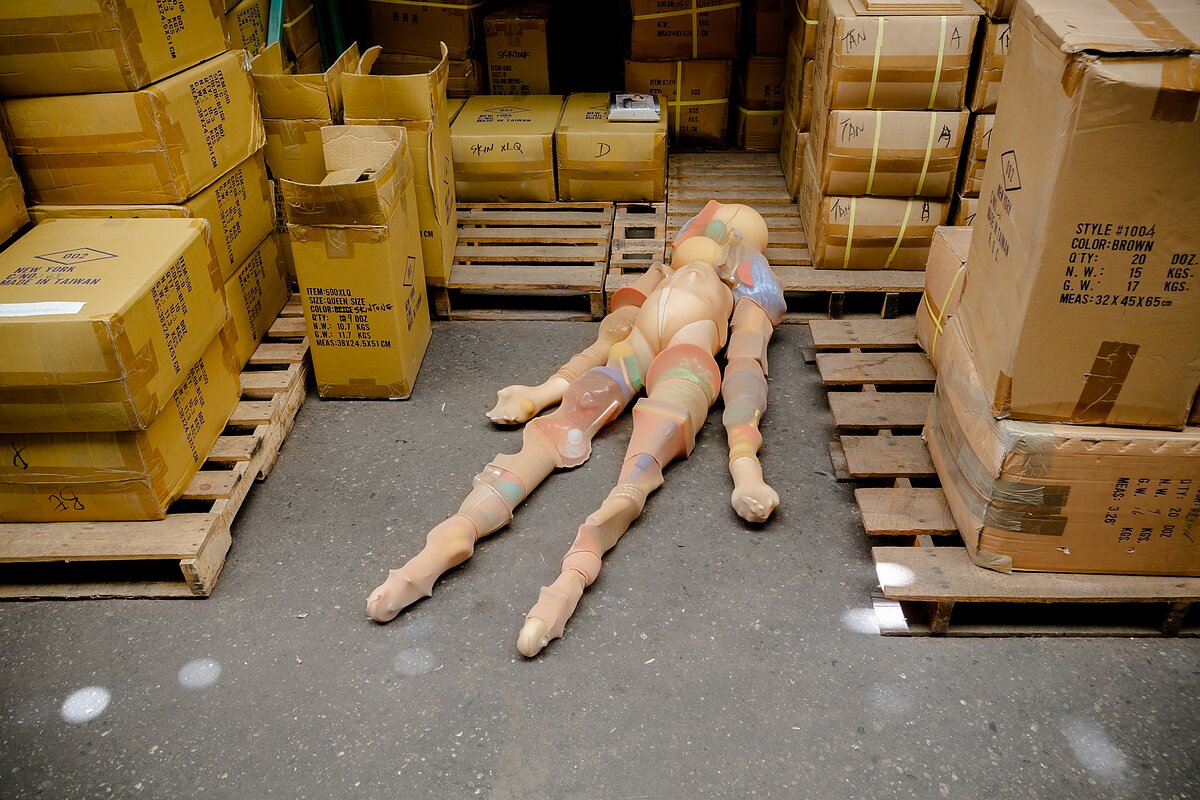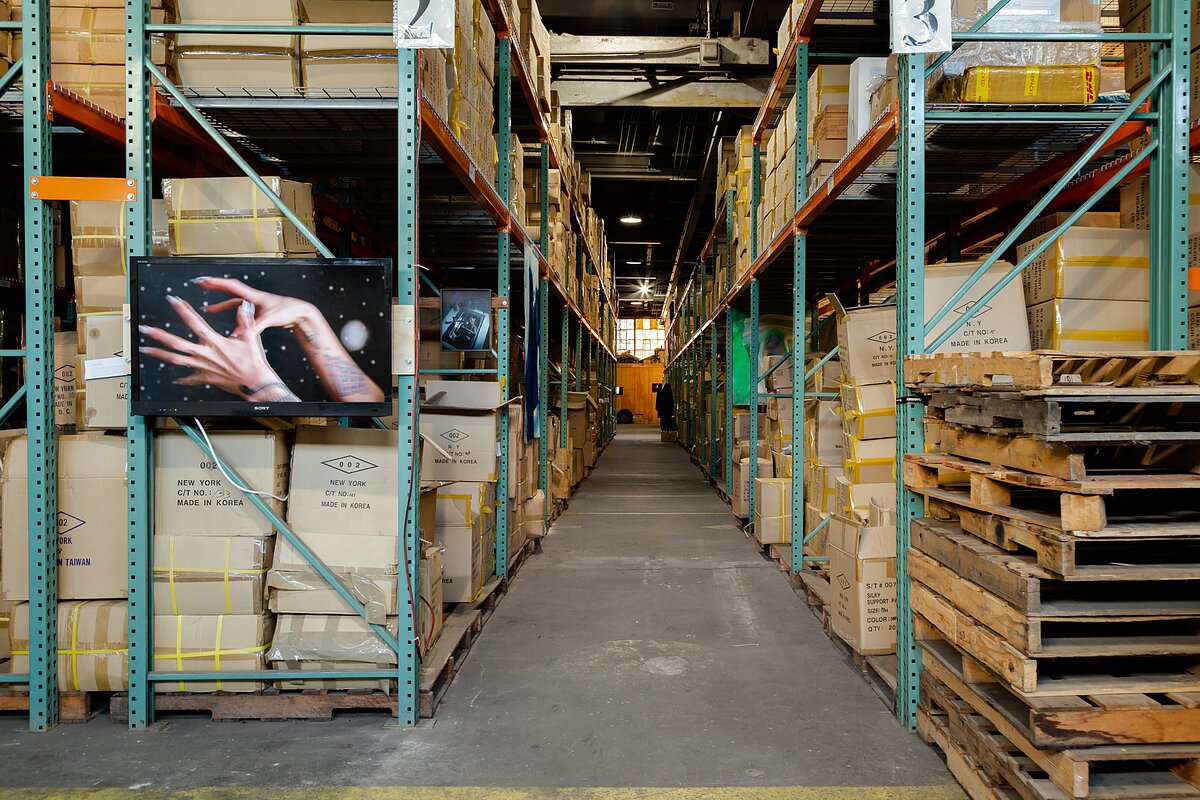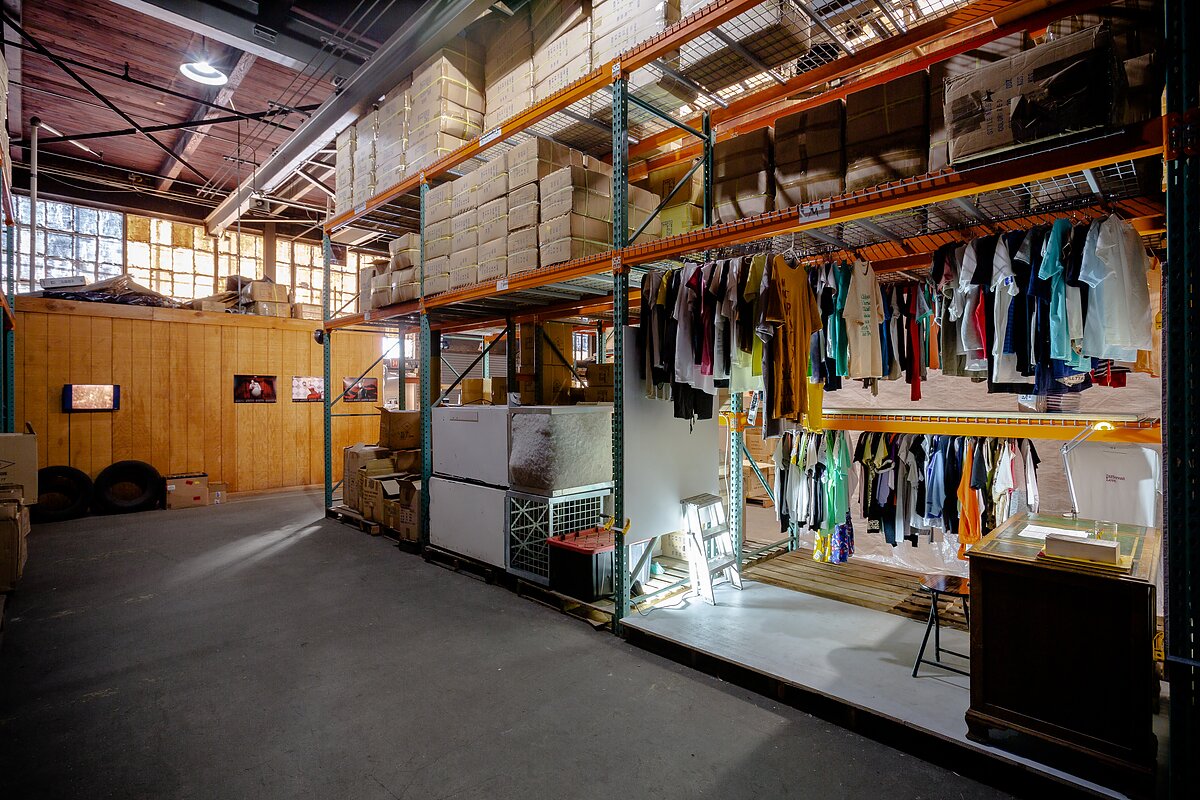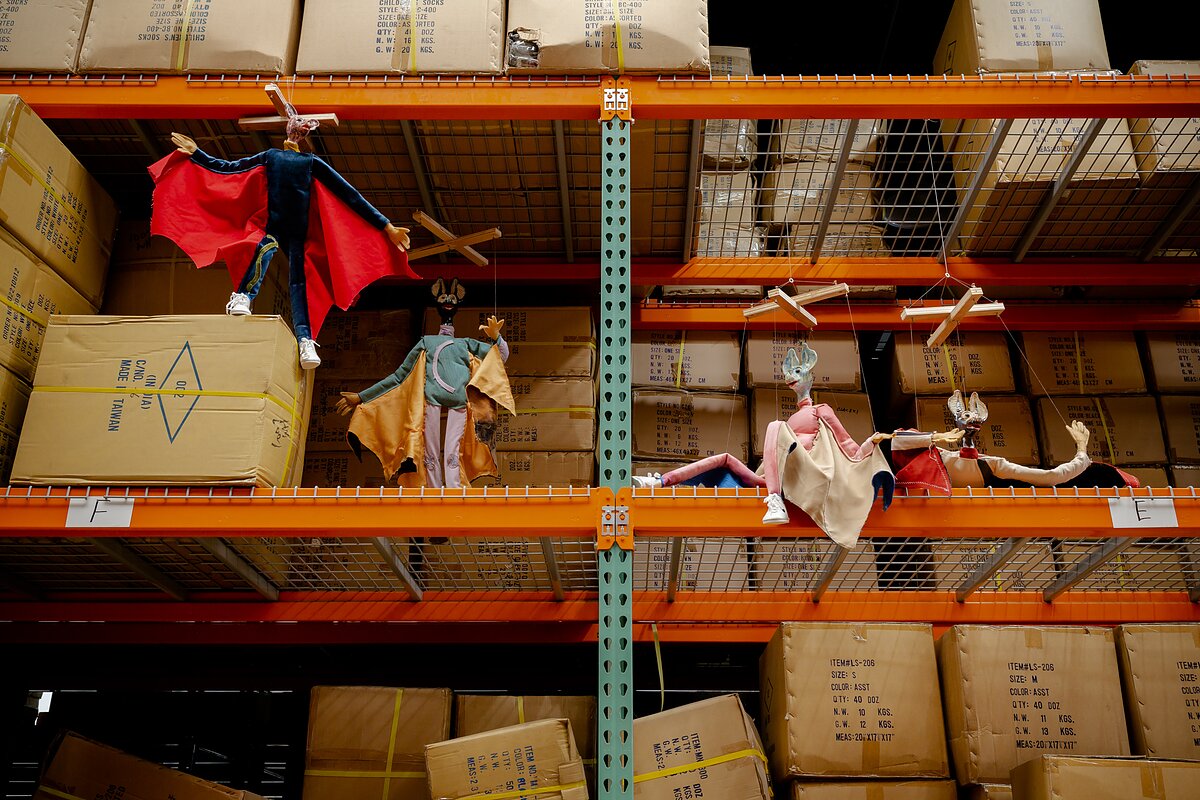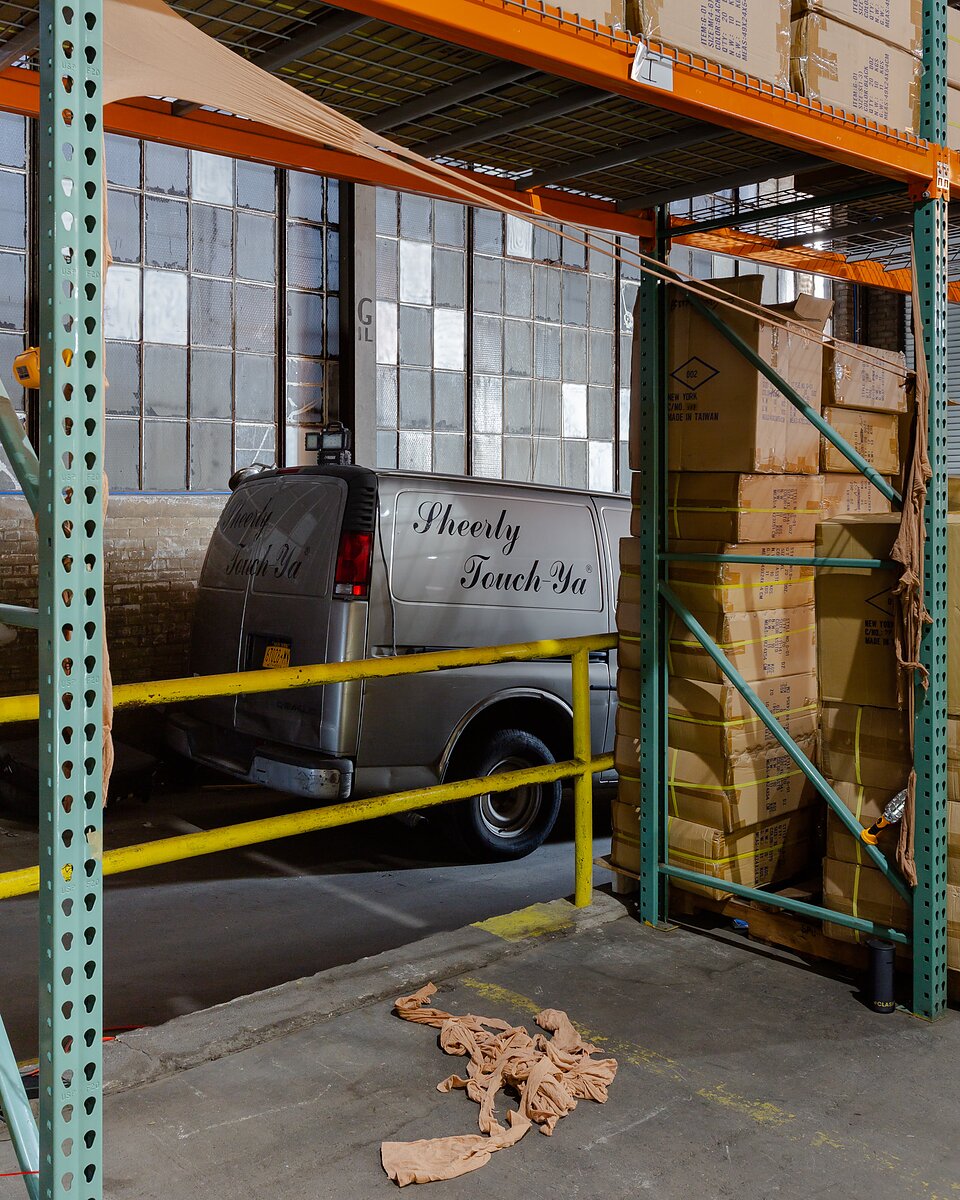“Means of Production” Exposes the Seams of Art and Commerce
Sculptures hide like mischievous children in dim aisles, projected lights pulse against cinderblock walls, and expressive gestures emerge from the corners of a functional yet invisibilized industrial setting. These are the sights and sensations that permeate “Means of Production,” a sprawling group exhibition installed by the curatorial collective Lunch Hour in a warehouse in Glendale, Queens.
The warehouse—home to Shisanwu LLC, a sculpture fabrication studio, and Sheerly Touch-Ya, a hosiery company owned by artist and Lunch Hour member Serena Chang—showcases the creative labor of around 75 predominantly Asian and AAPI artists on its loading dock. Placed between metal shelves and amid cardboard boxes stacked high on wooden pallets, works adopt the visual language of manufacturing and commerce, absorbing materials like stockings, cardboard, and glass sourced on-site. The result is a blurring of the line between art and commodity, and imbuing the warehouse environment, already a dense web of signification, with new and multivalent symbols.
At its mid-May opening, shouts from a live performance of Anh Vo’s Common Fetish (2024) erupted intermittently from the back of the warehouse. The spectrality of the performance was a refreshing rejoinder to the industrial spaces depicted in popular culture—full of anonymous bodies performing repetitive and exploitative tasks with the numbness of machinery.
Standout works in “Means of Production” include CFGNY’s Studio Phong (Cao Trí Cu)(2017), a suite of fashion editorials created in collaboration with a Vietnamese portrait studio, which comment on artistic self-representation and the division of labor; Banyi Huang’s Scream Starter Pack (2024), a diorama constructed like an advent calendar with 3D prints of the artist’s body parts and other objects displayed in repurposed Sheerly Touch-Ya packaging, an homage to the physical fatigue of the contemporary artist-worker; and Tianyi Sun’s Dream Skin (Sheerly) (2024), a screen-like sculpture made from lacy Sheerly Touch-Ya tights stretched, in an act of site-responsiveness and recuperation, over the warehouse’s discarded window panes.
These and other works poignantly illustrate what political theorist Achille Mbembe calls the “aesthetics of superfluity,” which literary scholar Anne Anlin Cheng, in her 2018 book Ornamentalism, eloquently describes as “that fragile mediation between indispensability and expendability that informs labor and life, especially at the height of imperialism and the subsequent global movements of bodies and things.”
Although “Means of Production” was curated around the issue of creative labor, the thematic threads tying together its wide range of artworks might also be bound by Cheng’s theory of ornamentalism, which traces how notions of personhood and objecthood have historically been co-constituted along lines of race and gender through negotiations with these globally circulating “bodies and things.”
In Bo Hao Chang’s Drifter (2024), for example, Sheerly Touch-Ya tights are stretched over mass-market products manufactured in Taiwan, including a mannequin head, foam balls, plastic traffic cones, and floor buffing brushes. The stuffed form resembles a human body lying on the warehouse floor, eulogizing what a nearby didactic calls “bodies that have disappeared in [the] process of industrialization.” However, this synthetic assemblage does more than pose as human. Here, that which is human about the figure emerges, in Cheng’s words, “as and through ornament.”
One of the pillars of Cheng’s theory is the obvious problem that arises when human beings are treated as things, or as hyperproductive yet uncreative machines that produce these things. Asian bodies are often coded this way in contemporary art. For example, in Cao Fei’s Whose Utopia (2006), the subjectivities of factory workers in China’s Pearl River Delta are dramatized through dance, but the dancers’ elegant movements are restricted by repeated gestures, juxtaposed with the precise articulations of machines. In Mika Rottenberg’s Cosmic Generator (2017), Asian women working in a wholesale market sit at their desks, typing, idling, or sleeping. Rottenberg’s film, intended to contrast the fluid circulation of goods with the restricted mobility of people, ends up drawing visual parallels between the women and the wares around them.
Conversely, “Means of Production” highlights the creative labor of Asian and AAPI artists as a gesture of remediation and solidarity. Several artworks illustrate this principle. Greeting viewers on the loading dock is Koa Pham’s An invitation to a dream (2024), a sculpture made of plywood and aluminum draped in a translucent, pale pink fabric and displayed on a platform cart. Exquisitely obsolete, this vaguely harp-shaped piece of pseudo-machinery is accompanied by an object label quoting a particularly awkward scene in Sofia Coppola’s Lost in Translation (2003), in which a sex worker commands Bob Harris, the film’s white protagonist, to rip her stockings. Bob, confused by her accented English, repeats, “Lip them?” In this brief exchange, sexual and commodity fetishism converge on the site of the laboring Asian body.
A work in the back of the warehouse, Trâm Nguyễn/Vinacringe’s a wound in the shape of the world (2024), seems to respond directly to the sex worker’s “invitation.” Here, deconstructed stockings are stretched like spiderwebs between metal shelving posts. In the center of the crisscrossed tights, a sharp-tipped chef knife, ostensibly what has ripped them, dangles from a red string. In what the object label describes as a “selfish ritual” charting the course of “heartbreak and rebirth,” the artist has transformed the fabric—simultaneously an ornament, a second skin, and a corporeal proxy—from the object of an erotic, exoticizing fantasy into a medium through which agency is reclaimed.
By making space for multiple, even contrasting, readings of a once static symbol like hosiery, “Means of Production” refracts the pertinent issue of labor through the lenses of art, commerce, race, and gender, while muddying the boundaries between each of these categories. Meanwhile, the show attunes its viewers to the artistic and political potential of a seemingly ordinary Queens warehouse, eliciting from the cardboard boxes, cinderblock walls, and dormant inventory subtle proof of its indispensability.
“Means of Production” is on view through July 31 at 74-12 88th St, Glendale, NY.
—Jenny Wu is a writer and independent curator.

